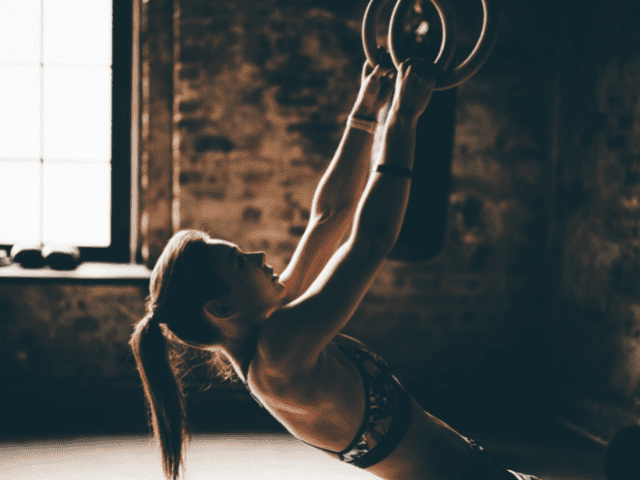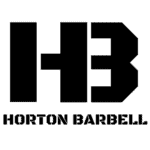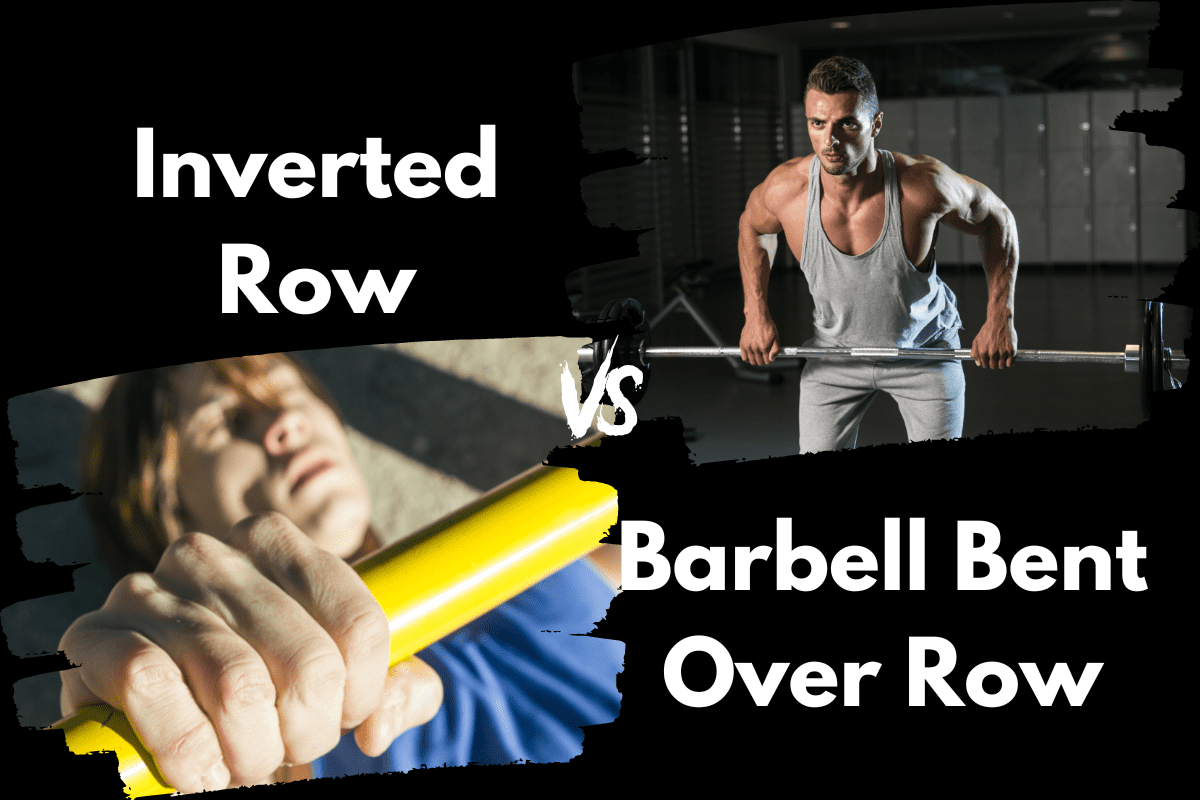Inverted Rows vs Barbell Bent Over Row (Which is Better?)
Inverted Rows and Barbell Bent Over Rows are both exercises that can be used to strengthen the upper back.
However, there are some key differences between the two exercises that may make one a better option than the other depending on the individual’s fitness level and goals.
Inverted Rows, also known as bodyweight rows, are performed using a bar or other horizontal object that is elevated off the ground. The lifter grasps the bar with an overhand grip and pulls their body up towards the bar, keeping their body straight and their heels on the ground.
In contrast, Barbell Bent Over Row is performed by holding a barbell with an overhand grip and bending the hips and knees to lower the upper body, keeping the back straight. The individual then lifts the barbell towards the chest, using the muscles of the upper back to perform the movement.
In this article, I’m going to cover, in detail, how to do each exercise. Then, I’ll break down which exercise is better depending on what your specific goal is.
Inverted Rows

Equipment Needed
- Barbell*
- Squat Rack
*I generally do Inverted Rows with a barbell in a rack, but if you have rings (as pictured above) they work great as well.
Step-by-Step Instructions
- Start by placing a bar on the rack about waist height.
- The higher the bar is placed, the easier the rows will be. The lower the bar is placed, the harder the rows will be. (Just make sure to leave yourself enough room to fully extend your arms at the bottom of the rep)
- Set the bar on either the J-Hooks or the Safety Bars
- Lay down underneath the bar.
- Grab the bar with an overhand grip, brace the core and make sure your body is fully extended – including your legs.
- You should be positioned to where when you pull yourself up towards the bar, the bar touches the same spot on the chest as it would for bench press. Slide up or down to adjust accordingly.
- Now, keeping your body in a straight line, pull your chest up to the bar and lower back down until your arms are fully extended.
- Repeat until all reps are completed.
Coaching Points
There are two common mistakes that I see all the time when it comes to Inverted Rows.
One, athletes I coach love to either pull their face to the bar or even raise their chin up and over the bar like a pull-up. These are both wrong.
You should think of the Inverted Row like a reverse bench press. Keep your head back, chest out and pull your chest directly to the bar. Pull the shoulder blades down and back at the top of the rep and squeeze the back.
The second mistake I see all too often is tired athletes that start to look like they’re doing the worm. They start rocking and rolling their entire body to try to get their chest up to the bar. Don’t do this! Maintain a rigid body posture and continue pulling yourself as high as you can each rep.
Inverted Rows are sometimes referred to as Inverted Pull-ups and/or my personal favorite, Aussie Pull-ups. If you see one of those names in a program or workout, they are most likely referring to the same exercise.
Related –> 13 of my favorite Inverted Row alternatives and variations

Tired of coming up with your own workouts? But don’t want to pay an arm and a leg?
I post workouts 5 days a week right here. (Did I mention they’re free?)
Barbell Bent Over Row

Equipment Needed
- Barbell
- Bumper or Iron Plates
- Lifting Straps (optional)
Step-by-Step Instruction
- Approach the barbell and take a shoulder-width stance. Your shins should be almost touching the barbell.
- Hinge at the waist and bend the knee until you can grab the barbell. Use a pronated grip (Knuckles facing the floor). I will talk later about the supinated grip (palms up) in this movement.
- Always keep a flat back, and a neutral spine, and keep your eyes focused slightly down about 1 foot in front of you.
- Take a deep breath, brace the abdomen, and pull the bar in until it makes contact right about the belly button.
- Pause for about 1 second. Squeeze the shoulder blades and lock in the rep.
- Slowly return the barbell back to the starting position (weights about 1-2 inches off the ground).
Coaching Points
The initial setup and stance for Barbell Bent Over Rows should be specific to the lifter’s deadlifting and Olympic lifting goals. Having identical setups and grips will be great for the lifts to carry over to the compound movements.
I would highly recommend this movement to any lifter or athlete. It develops strength in the posterior chain and can be overloaded over time easily.
I typically recommend the pronated grip here for athletes. Especially athletes that are cleaning and snatching as the pronated grip will carry over to cleans and pulls.
However, there is some benefit to the supinated grip for general lifters and bodybuilders. The supinated grip will engage more of the biceps and can be a great time under tension movement for hypertrophy.
Inverted Rows vs Barbell Rows: Which Is Better?
Now, let’s compare the two exercises directly to see which is better for specific goals.
Better For Developing Strength: Barbell Rows
I believe this depends on each individual’s current level of strength.
I think both are great (and relatively close) at developing strength for the beginner to intermediate-level lifter.
However, at a certain point, it will be hard to continue to challenge an advanced lifter with Inverted Rows. Even modifications like elevating the feet and adding extra resistance (wearing a weight vest for example) will lose their effectiveness.
I’ve had athletes who could throw on a 20-pound weight vest, lay a 45-pound plate on their chest, elevate their feet on a bench – and still easily do a set of 10 to 15 reps.
On the other hand, Barbell Bent Over Rows has a much higher ceiling to develop strength. Even elite-level powerlifters can add enough weight to the bar to continue building strength with Barbell Rows.
Better For Hypertrophy: Barbell Rows
I give the edge to Barbell Rows for building hypertrophy as well.
First, for some of the same reasons they have an advantage at developing strength – the ceiling to continue to grow (pun intended) is higher with Barbell Bent Over Rows.
But, also, the fact that Barbell Rows also engage the low back and core to brace and stabilize the body will make them more effective at building muscle. Anytime you can get more muscle groups involved in an exercise, the better chance you have at hypertrophy.
Better For Beginners: Inverted Rows
Inverted Rows are the clear choice for beginners. First, Inverted Rows use your own bodyweight which I absolutely love for beginners. You should become proficient at moving your own body weight before you start loading a bunch of weight onto a barbell.
Second, the body position needed to execute Inverted Rows is much more forgiving to technique flaws than Barbell Rows. Bent Over Rows demand you to be able to maintain a flat back and braced core while you row. If you’re unable to do this, it could result in injury.
Inverted Rows will teach a lifter how to brace and maintain a neutral body position. However, if they lose their body position the consequences are not nearly as severe as they can be with Barbell Rows.

Get Shredded… For Free
Get a free workout Monday through Friday, posted right here on Horton Barbell. These workouts are designed to help you get strong, in shape and look great at the beach!
Final Thoughts
I’ve just spent an entire article comparing which is better – Inverted Rows or Barbell Bent Over Rows. However, the truth is, there is no reason you shouldn’t have both exercises in your strength training program.
Both are excellent exercises for building upper-body strength and hypertrophy. Incorporating both into your training program can also add much-needed variety and keep your plan from getting stale.
So, my suggestion would be instead of trying to decide between the two exercises, figure out how you can utilize both Inverted Rows and Barbell Bent Over Rows in your training plan.
More Links and Info
Check out how Inverted Rows compare to some other popular back exercises:

